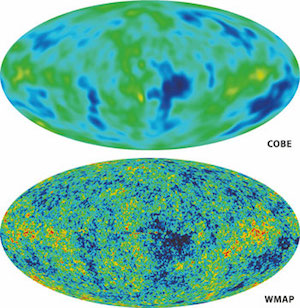Seeds of Modern Universe
Cosmic researchers now have the clearest view ever of the universe's early structure – clusters of galaxies, and clusters of clusters of galaxies. The better view comes in the form of super-sensitive temperature data of the Cosmic Microwave Background (CMB) collected by the Wilkinson Microwave Anisotropy Probe (WMAP). The CMB is the afterglow (left-over light) of the Big Bang.
WMAP has greatly improved on the fuzzier, first map of the CMB made in 1993. That first map was made with data from NASA's Cosmic Background Explorer satellite (COBE).

Image credit: NASA
Comparison of the COBE (top) and WMAP (bottom) results. WMAP has a higher sensitivity to small temperature changes than COBE. From these fluctuations astronomers can determine properties of the universe.
What WMAP has now confirmed are "peaks" of the Big Bang shockwaves in the CMB. These were first observed in 1999 and 2000 with ground-based instruments. These observations lead to the conclusion that the geometry of the universe is flat. What that means is that in space, on a large scale, parallel lines would stay parallel.
WMAP's measurement of these peaks gives the amount of normal and dark matter in the universe. This information, combined with knowing the universe is flat, shows astronomers what the total matter and energy composition of the universe must be. Normal matter makes up 4% of the universe and dark matter 23%. Therefore, dark energy makes up 73%. This falls right in the range of the amount of gravity-repelling dark energy discovered in 1998.
WMAP has also, for the first time, discovered the polarization of light everywhere in the CMB. This is important because it helps us understand what happened during the first split second after the Big Bang. That's when the universe puffed up like a lump of bread dough. That moment astronomers call inflation caused tiny variations in the original Big Bang to form slight differences in temperature seen in the CMB. Those differences, in turn, are thought to be the seeds of today's gigantic clusters of galaxies which are strung together like cobwebs throughout the universe.
Researchers are now comparing and combining the new WMAP data with a range of other cosmic measurements to uncover a new understanding of the universe's past, present and future. •



